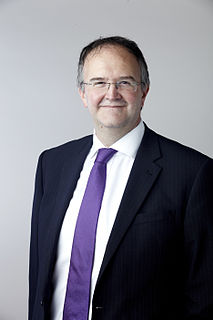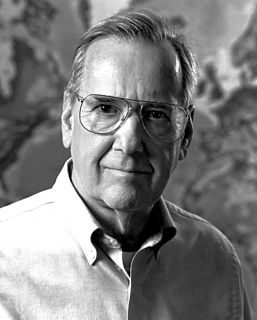Related Research Articles

Virology is the scientific study of biological viruses. It is a subfield of microbiology that focuses on their detection, structure, classification and evolution, their methods of infection and exploitation of host cells for reproduction, their interaction with host organism physiology and immunity, the diseases they cause, the techniques to isolate and culture them, and their use in research and therapy.
An emergent virus is a virus that is either newly appeared, notably increasing in incidence/geographic range or has the potential to increase in the near future. Emergent viruses are a leading cause of emerging infectious diseases and raise public health challenges globally, given their potential to cause outbreaks of disease which can lead to epidemics and pandemics. As well as causing disease, emergent viruses can also have severe economic implications. Recent examples include the SARS-related coronaviruses, which have caused the 2002-2004 outbreak of SARS (SARS-CoV-1) and the 2019–21 pandemic of COVID-19 (SARS-CoV-2). Other examples include the human immunodeficiency virus which causes HIV/AIDS; the viruses responsible for Ebola; the H5N1 influenza virus responsible for avian flu; and H1N1/09, which caused the 2009 swine flu pandemic. Viral emergence in humans is often a consequence of zoonosis, which involves a cross-species jump of a viral disease into humans from other animals. As zoonotic viruses exist in animal reservoirs, they are much more difficult to eradicate and can therefore establish persistent infections in human populations.

Vincent R. Racaniello is a Higgins Professor in the Department of Microbiology and Immunology at Columbia University's College of Physicians and Surgeons. He is a co-author of a textbook on virology, Principles of Virology.

A viral disease occurs when an organism's body is invaded by pathogenic viruses, and infectious virus particles (virions) attach to and enter susceptible cells.

A virus is a submicroscopic infectious agent that replicates only inside the living cells of an organism. Viruses infect all life forms, from animals and plants to microorganisms, including bacteria and archaea. Since Dmitri Ivanovsky's 1892 article describing a non-bacterial pathogen infecting tobacco plants and the discovery of the tobacco mosaic virus by Martinus Beijerinck in 1898, more than 9,000 virus species have been described in detail of the millions of types of viruses in the environment. Viruses are found in almost every ecosystem on Earth and are the most numerous type of biological entity. The study of viruses is known as virology, a subspeciality of microbiology.
Anthony (Tony) Charles Minson, PhD, FMedSci is a British virologist known for his work on the biology of herpesviruses, and a university administrator. He was the Senior Pro-Vice-Chancellor of the University of Cambridge from 2003 to 2009. He is emeritus professor of virology at the university's Department of Pathology and an emeritus fellow of Wolfson College.
Diane Edmund Griffin is the University Distinguished Professor and a Professor in the Department of Molecular Microbiology and Immunology at the Johns Hopkins Bloomberg School of Public Health, where she was the department chair from 1994-2015. She is also the current vice-president of the National Academy of Sciences. She holds joint appointments in the departments of Neurology and Medicine. In 2004, Griffin was elected to the United States National Academy of Sciences (NAS) in the discipline of microbial biology.
Alice S. Huang (simplified Chinese: 黄诗厚; traditional Chinese: 黃詩厚; pinyin: Huáng Shīhòu; Wade–Giles: Huang Shih-hou; is an American biologist specialized in microbiology and virology. She served as President of AAAS during the 2010-2011 term.

Peter Palese is a United States microbiologist and Professor and Chair of the Department of Microbiology at the Icahn School of Medicine at Mount Sinai in New York City, and an expert in the field of RNA viruses.
In biology, a pathogen in the oldest and broadest sense, is any organism or agent that can produce disease. A pathogen may also be referred to as an infectious agent, or simply a germ.
Ronald C. Kennedy was a virus immunologist at Texas Tech University. Prior to his appointment there he was affiliated with Baylor University, where he had previously done postdoctoral studies. Furthermore, when he switched affiliations to Texas Tech, he was also an adjunct, associate and full professor in the Departments of Microbiology and Pediatrics at the University of Texas Health Science Center at San Antonio. After his tenure in San Antonio, he switched affiliations to the University of Oklahoma Health Sciences Center's department of microbiology and immunology. In the 1980s he was affiliated with the Southwest Foundation for Biomedical Research, during which time he published some research pertaining to SV40 and intracellular protein transport. More recently, Kennedy has published some research regarding DNA vaccination, mostly in the journal Cancer Immunology, Immunotherapy.

Nicholas José Talbot FRS FRSB is Group Leader and Executive Director at The Sainsbury Laboratory in Norwich.

Akiko Iwasaki is a Sterling Professor of Immunobiology and Molecular, Cellular and Developmental Biology at Yale University. She is also a principal investigator at the Howard Hughes Medical Institute. Her research interests include innate immunity, autophagy, inflammasomes, sexually transmitted infections, herpes simplex virus, human papillomavirus, respiratory virus infections, influenza infection, T cell immunity, commensal bacteria, COVID-19 and Long COVID.

Robert Ellis Shope was an American virologist, epidemiologist and public health expert, particularly known for his work on arthropod-borne viruses and emerging infectious diseases. He discovered more novel viruses than any person previously, including members of the Arenavirus, Hantavirus, Lyssavirus and Orbivirus genera of RNA viruses. He researched significant human diseases, including dengue, Lassa fever, Rift Valley fever, yellow fever, viral hemorrhagic fevers and Lyme disease. He had an encyclopedic knowledge of viruses, and curated a global reference collection of over 5,000 viral strains. He was the lead author of a groundbreaking report on the threat posed by emerging infectious diseases, and also advised on climate change and bioterrorism.
Guan Yi is a Chinese virologist. In 2014, he was ranked as 11th in the world by Thomson Reuters among global researchers in the field of microbiology. He obtained his PhD in microbiology at the University of Hong Kong and is now a professor of microbiology at his alma mater. His research on the viral respiratory disease SARS helped the Chinese government avert the 2004 outbreak of this disease. He is the current director of the State Key Laboratory for Emerging Infectious Diseases University of Hong Kong. In early 2017, Guan warned that the H7N9 influenza virus "poses the greatest threat to humanity than any other in the past 100 years".
Anne Moscona is an American virologist and pediatrician. She is best known for identifying cell entry mechanisms for enveloped respiratory viruses, elucidating general infection mechanisms that apply to parainfluenza virus, Nipah virus, measles virus, and other viruses, and for applying this knowledge to identify antiviral strategies to prevent infection by viruses including SARS-CoV-2. She is frequently consulted as a medical expert during viral outbreaks, including epidemic and pandemic influenza. Since 2016, she has served as the Sherie L. Morrison Professor Microbiology & Immunology, Professor of Pediatrics, and Professor of Physiology & Cellular Biophysics at Columbia University Medical Center in New York City, where she directs the Center for Host Pathogen Interaction. In 2022, Moscona was elected as president of the American Society for Virology, the nation's leading virology research organization, and will lead the organization starting in July 2023. For the last two years she has served the American Society for Virology as Councilor for Medical Virology.
Charles Albert Evans was an American physician, professor of microbiology, and researcher on poliomyelitis virus. He was the president of the American Society for Microbiology in 1960.
Aaron Frederick "Fred" Rasmussen Jr. was an American physician, professor of microbiology and immunology, and, later in his career, associate dean of the UCLA School of Medicine. He is known for his pioneering research in psychoneuroimmunology.
Edwin Herman Lennette was an American physician, virologist, and pioneer of diagnostic virology.
Dennis John O'Callaghan is an American virologist, immunologist, and biochemist. He is an internationally recognized expert on the molecular biology of the equine herpesviruses.
References
- ↑ "CVMBS Microbiology, Immunology & Pathology Dept - Calisher, Charles". www.cvmbs.colostate.edu.
- ↑ Monath, Thomas P.; Murphy, Frederick A. (October 20, 2021). "Introduction and Tribute to Charlie Calisher". Diseases. 9 (4): 75. doi:10.3390/diseases9040075. PMC 8544375 . PMID 34698130 – via PubMed Central.
- ↑ Glaser, Vicki (2005). "Interview with Charles H. Calisher, Ph.D." Vector-Borne and Zoonotic Diseases. 5 (2): 212–217. doi:10.1089/vbz.2005.5.212. PMID 16011439.